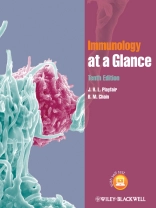Immunology at a Glance provides a user-friendly overview
of the body’s defence mechanisms. Ideal from day one of a
medical, biomedical or life science course, the text begins with a
basic overview of both adaptive and innate immunity, before
progressing to applied immunological concepts, which look at what
happens when things go wrong, and how, in clinical medicine, each
body system can be affected by immunity.
Each double-page spread corresponds to a typical lecture and
diagrammatically summarises core concepts in immunology, through
accessible schematic diagrams on left-hand pages, with key points
concisely summarised on the right-hand page. There are also
self-assessment essay questions so you can test your knowledge.
New for this 10th edition:
* Thoroughly updated and reorganised chapters offer greater
clarity and easier understanding for those new to the subject
* New chapters on cytokine receptors and ‘Immunology in the
Laboratory’
* A completely re-written section on autoimmunity
* A brand new companion website featuring self-assessment
questions and Power Point slides of images from the book, ideal for
teaching and revision at href=’http://www.ataglanceseries.com/immunology’>www.ataglanceseries.com/immunology
Immunology at a Glance is the ideal companion for anyone
about to start a new course in immunology and will appeal to
medical and biomedical science students. Perfect for exam
preparation, it provides the concepts and frameworks you need to
succeed in your exam.
Jadual kandungan
Preface 6
Acknowledgements 6
Note on the tenth edition 6
How to use this book 7
Further reading 7
List of abbreviations 8
Immunity
1 The scope of immunology 10
2 Innate and adaptive immune mechanisms 12
3 Recognition and receptors: the keys to immunity 14
4 Cells involved in immunity: the haemopoietic system 16
Innate immunity
5 Receptors of the innate immune system 18
6 Complement 20
7 Acute inflammation 22
8 Phagocytic cells and the reticuloendothelial system 24
9 Phagocytosis 26
Adaptive immunity
(i) The molecular basis
10 Evolution of recognition molecules: the immunoglobulin superfamily 28
11 The major histocompatibility complex 30
12 The T-cell receptor 32
13 Antibody diversification and synthesis 34
14 Antibody structure and function 36
(ii) The cellular basis
15 Lymphocytes 38
16 Primary lymphoid organs and lymphopoiesis 40
17 Secondary lymphoid organs and lymphocyte traffic 42
(iii) The adaptive immune response
18 Antigen processing and presentation 44
19 The antibody response 46
20 Antigen – antibody interaction and immune complexes 48
21 Cell-mediated immune responses 50
(iv) Regulation
22 Tolerance 52
23 Cell communication and cytokines 54
24 The cytokine network 56
25 Immunity, hormones and the brain 58
Potentially useful immunity
26 Antimicrobial immunity: a general scheme 60
27 Immunity to viruses 62
28 HIV and AIDS 64
29 Immunity to bacteria 66
30 Immunity to fungi and ectoparasites 68
31 Immunity to protozoa 70
32 Immunity to worms 72
Undesirable effects of immunity
33 Immunodeficiency 74
34 Harmful immunity: a general scheme 76
35 Allergy and anaphylaxis 78
36 Immune complexes, complement and disease 80
37 Chronic and cell-mediated inflammation 82
38 Autoimmune disease 84
Altered immunity
39 Transplant rejection 86
40 Immunosuppression 88
41 Immunostimulation and vaccination 90
Immunity in health and disease
42 Cancer immunology 92
43 Immunity and clinical medicine 94
44 Investigating immunity 96
45 Immunology in the laboratory 98
46 Out of the past: evolution of immune mechanisms 100
47 Into the future: immunology in the age of genomics 102
Self-assessment
Self-assessment questions 105
Answers 107
Appendices
Appendix I Comparative sizes and molecular weights 109
Appendix II Landmarks in the history of immunology and some unsolved problems 111
Appendix III CD classification 113
Index 115
Mengenai Pengarang
Professor John H L Playfair, MB BChir Ph D DSc, Emeritus Professor of Immunology, University College London, UK.
Professor Benjamin M Chain BA, Ph D, FRCPath, Professor of Immunology and Head of Department at the Windeyer Institute of Medical Sciences, University College London, UK.












